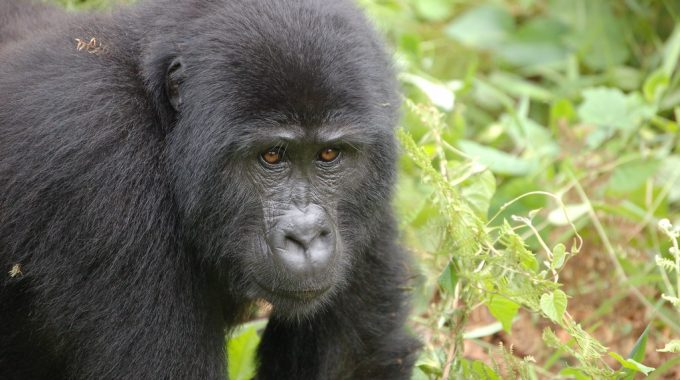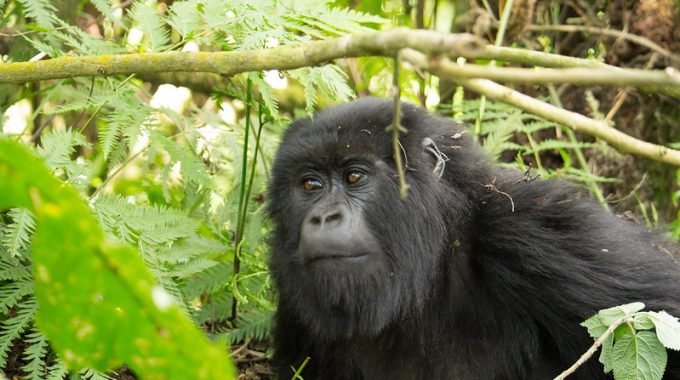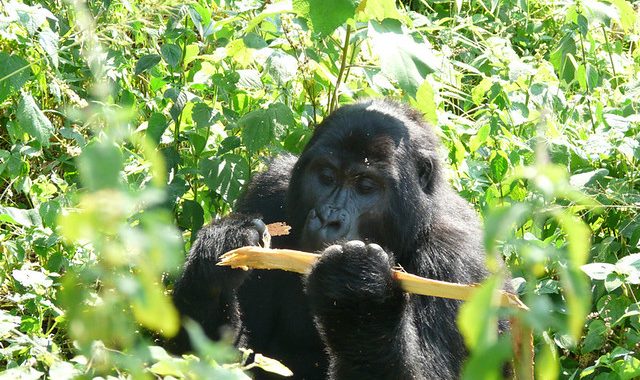Uganda Wildlife Authority gorilla permits actually means Uganda gorilla safaris for Bwindi Impenetrable National park…
Types of Gorillas
Types of Gorillas – There are two species of gorillas: the Eastern Gorilla (Gorilla beringei) and the Western Gorilla (Gorilla gorilla). Each species has two subspecies—with distinct characteristics, behaviors, and habitats. Here’s a detailed breakdown of the four types of gorillas:

1. Western Gorilla (Gorilla gorilla)
The Western Gorilla is the most widely distributed of the two species. It is found in central and western Africa, primarily in the rainforests of countries like Cameroon, the Central African Republic, the Republic of Congo, Gabon, and Equatorial Guinea. This species is further divided into two subspecies:
a. Western Lowland Gorilla (Gorilla gorilla gorilla)
- Physical Characteristics:
-
- The Western Lowland Gorilla is the smallest of the gorilla subspecies. Adult males (silverbacks) typically weigh between 300 to 400 pounds (135–180 kg), while females are smaller, weighing around 150–200 pounds (70–90 kg).
- They have a shorter, darker coat, with black or dark brown fur.
- Habitat:
-
- They live primarily in the lowland tropical rainforests of central and western Africa (from Cameroon to the Republic of Congo and Gabon).
- Their habitat is typically dense forest and swampy regions.
- Diet:
-
- These gorillas are herbivores, feeding on fruits, leaves, stems, and occasionally tree bark.
- They also eat terrestrial herbs and bamboo shoots, depending on the season.
- Behavior:
-
- Western Lowland Gorillas are generally shy and peaceful. They live in social groups, usually led by a dominant silverback.
- Their social groups can range in size from 2 to 20 members.
- Conservation Status:
-
- Critically Endangered: Due to habitat destruction, poaching, and the spread of diseases like Ebola, the Western Lowland Gorilla population has drastically declined in recent years.
b. Cross River Gorilla (Gorilla gorilla diehli)
- Physical Characteristics:
-
- Cross River Gorillas are very similar in appearance to Western Lowland Gorillas but are slightly smaller and more robust.
- Adult males weigh about 300–400 pounds (135–180 kg), and females are generally smaller.
- Habitat:
-
- The Cross River Gorilla is one of the rarest gorilla subspecies, found only in the mountainous regions along the Cross River that forms the border between Nigeria and Cameroon.
- They inhabit the forest-clad hills and lowland forests at altitudes between 500 to 1,500 meters (1,640 to 4,920 feet).
- Diet:
-
- They primarily eat leaves, fruits, and stems, similar to other gorilla subspecies, but also consume a variety of plants native to their unique environment.
- Behavior:
-
- The Cross River Gorilla is extremely isolated and scarce, with fewer than 300 individuals remaining in the wild.
- They are typically seen in small family groups, often comprising of one silverback and several females and their offspring.
- Conservation Status:
-
- Critically Endangered: There are only around 200–300 individuals remaining, largely due to habitat fragmentation, poaching, and human-wildlife conflict.
2. Eastern Gorilla (Gorilla beringei)
The Eastern Gorilla is found primarily in the mountainous regions of central and eastern Africa, in countries like Uganda, Rwanda, and the Democratic Republic of Congo (DRC). It has two subspecies, one of which is found in high-altitude regions, while the other inhabits lowland forests.
a. Mountain Gorilla (Gorilla beringei beringei)
- Physical Characteristics:
-
- Mountain Gorillas are larger than their lowland relatives. Adult males (silverbacks) can weigh between 350 to 485 pounds (160–220 kg), while females weigh around 150–220 pounds (70–100 kg).
- Their fur is longer and thicker, adapted for the cooler high-altitude climate.
- Habitat:
-
- They live in the Virunga Mountains (which stretch across Rwanda, Uganda, and the DRC) at altitudes ranging from 2,000 to 4,500 meters (6,600 to 14,800 feet).
- Their environment consists of dense forests, alpine meadows, and bamboo forests.
- Diet:
-
- They feed on a variety of vegetation, including leaves, bamboo shoots, and fruits, with a preference for lowland bamboo and other high-altitude plants.
- Behavior:
-
- Mountain Gorillas live in smaller social groups than lowland gorillas, typically ranging from 5 to 30 individuals. The groups are usually led by a dominant silverback.
- They exhibit peaceful behaviors and are highly social, with strong bonds between family members.
- Conservation Status:
-
- Endangered: The population of Mountain Gorillas has made a remarkable recovery due to conservation efforts, but they remain vulnerable due to threats like habitat loss, poaching, and disease. There are about 1,000 individuals remaining in the wild.
b. Eastern Lowland Gorilla (Gorilla beringei graueri)
- Physical Characteristics:
- Eastern Lowland Gorillas are larger and heavier than Western Lowland Gorillas, with adult males (silverbacks) weighing around 400 to 450 pounds (180–200 kg).
- They have a dense coat of fur, which is typically darker than that of the Western Lowland Gorilla.
- Habitat:
- Found in the lowland forests of eastern Democratic Republic of Congo (DRC), they inhabit forests at altitudes ranging from 500 to 2,000 meters (1,640 to 6,600 feet).
- They live in areas with dense rainforests, swamps, and forest clearings.
- Diet:
- Their diet is similar to other gorillas, consisting mostly of leaves, fruits, stems, and bamboo.
- Behavior:
- Eastern Lowland Gorillas are larger and more powerful than their western counterparts but exhibit similar behaviors, living in family groups led by a dominant silverback.
- Conservation Status:
- Endangered: The population of Eastern Lowland Gorillas has declined significantly due to habitat loss, poaching, and civil unrest in the DRC. Fewer than 5,000 individuals remain in the wild.
Summary of Gorilla Types:
| Gorilla Species/Subspecies | Habitat | Physical Characteristics | Conservation Status |
| Western Gorilla (Gorilla gorilla) | Central & Western Africa (lowlands) | Smaller, shorter fur | Critically Endangered |
| – Western Lowland Gorilla | Dense rainforests of central Africa | Smaller size, dark coat | Critically Endangered |
| – Cross River Gorilla | Forests of Nigeria/Cameroon | Slightly smaller, robust build | Critically Endangered |
| Eastern Gorilla (Gorilla beringei) | Eastern & Central Africa (mountain) | Larger, thicker fur | Endangered |
| – Mountain Gorilla | Virunga Mountains (Rwanda, Uganda) | Larger, long fur for cold climate | Endangered |
| – Eastern Lowland Gorilla | Lowland forests of the DRC | Larger, denser fur | Endangered |
Conservation Note:
All four subspecies of gorillas are either Endangered or Critically Endangered, mainly due to habitat loss, poaching, disease, and civil unrest in their home regions. Conservation efforts are ongoing, and programs like habitat protection, anti-poaching initiatives, and ecotourism are essential for their survival.



